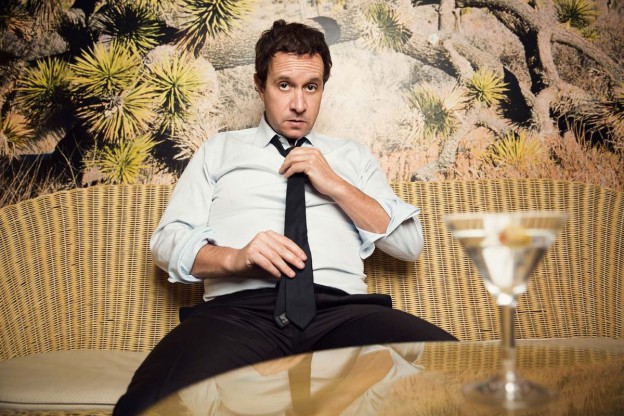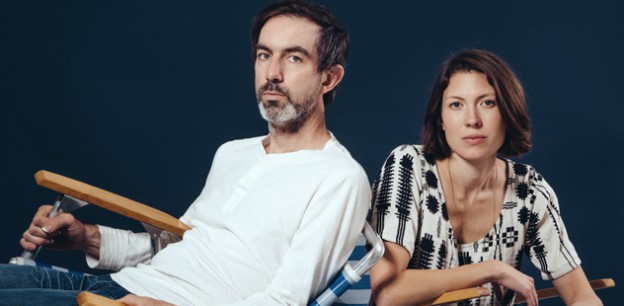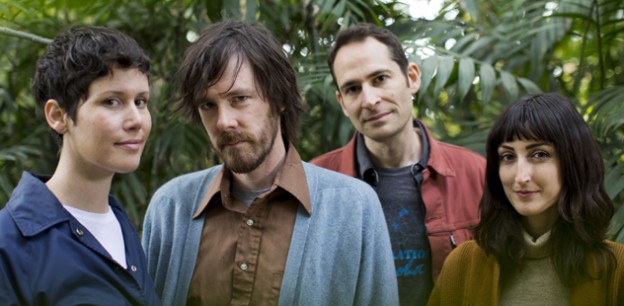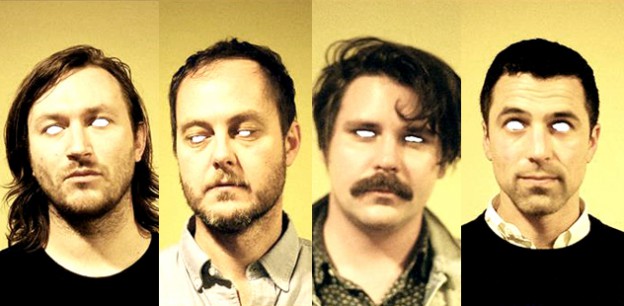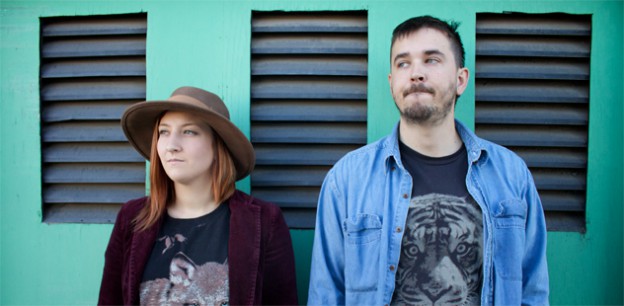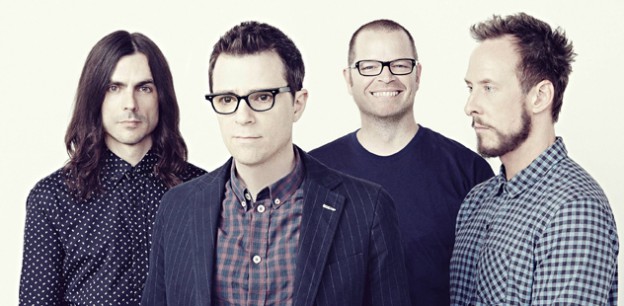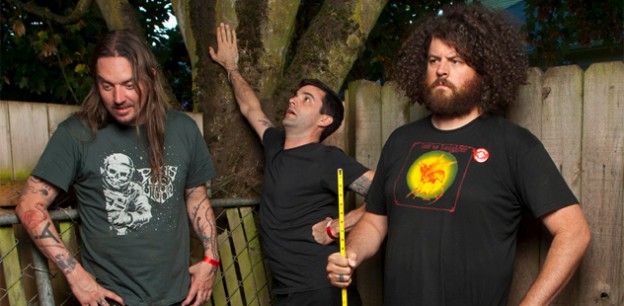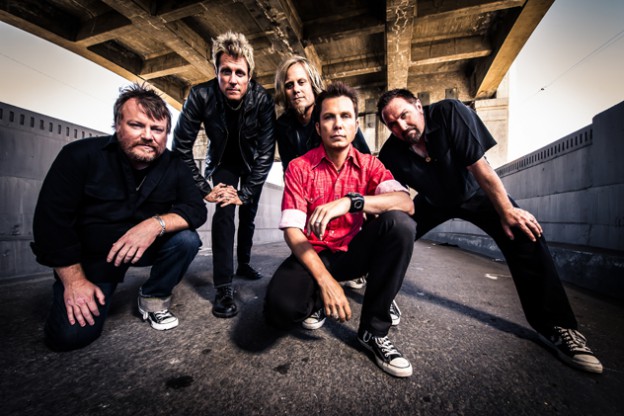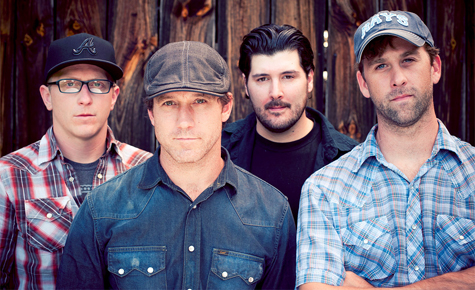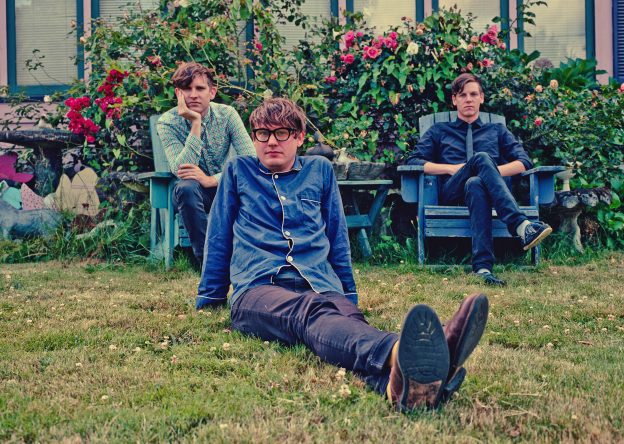Positively Pauly
Scene: It’s 1990 or 1991. You are a pop-culture sponge, spending long hours in front of the television set, beginning to notice the opposite sex, starting to cultivate your own sense of individuality. You are listening to bitchin’ music. You are amazed and annoyed, elated and embarrassed by everything you see, hear, smell, touch or taste. Then you see him—some curly-haired punk-Steven Tyler making strange carnal noises with his mouth, calling you “Buuu … ddy” and calling himself a weasel, courting throngs of tanned-skinned revelers for MTV’s Spring Break. A year later he stars in a film about guiding a thawed-out caveman through the Encino school system with a guy who later grows up to play Samwise Gamgee.
You have found your ultimate god-figure, and you’re not even a teenager yet. AND SCENE.
Pardon the indulgence of regurgitating what is mainly my personal experience with relation to the now-legendary comedian Pauly Shore. That my introduction to Shore was hardly unique, in a relative sense, is important when thinking about who Shore is now, who you are now, who Shore thinks he is now and how most people feel about him now. This is an exercise in the metaphysical world of Pauly Shore and Those He Has Influenced, and there are not nearly enough words assigned to tackle the whole boiling mass.
As unfortunate as it is, the ebb and flow of show business can be unforgiving to some people, and there are two camps you’ll find with regard to the phenomenon of Pauly Shore: those who aren’t assholes and appreciate entertainers in all their shapes and seasons, stars burning brightly or dully; and who that aren’t assholes, but just think Shore was never very funny to begin with.
There are probably other camps, too. Most notably those for whom the ephemera of Shore’s salad days ought to have just been bottled up in a time capsule and appreciated for what they were: the product of a comedian raised by comedians who was destined to be something big, no matter what it was.
This is all to comment on the fact that Pauly Shore is coming to town to do stand-up. Lots of nostalgia acts—regardless of the stigma such a tag may connote—have to deal with questions like Shore doubtlessly does all the time. They’re tough questions to ask. Remember when you did Son-In-Law? Remember when you did In the Army Now? Hey, by the way, working on anything new?
Luckily Shore is a bit of a workaholic, and has enjoyed much more exposure in recent years thanks to the explosion of comedy podcasts who line up to have him as a guest. After all, Shore’s mother owned and operated Los Angeles’ famous Comedy Store for decades, including during stand-up comedy’s heyday in the early to mid-‘80s. Shore’s father used to open up for Elvis Presley. Pauly himself was mentored by the late, great Sam Kinison. There’s a rich history here that is widely known and is great foddler for audio trips down memory lane.
In 2005, Shore produced and starred in the mockumentary Pauly Shore Is Dead, riffing on the idea of what mainstream America must have surely thought was the case stemming from Shore’s absence from the spotlight in the new millennium. An entirely more riveting, non-mocking documentary emerged in 2014 titled Pauly Shore Stands Alone followed Shore on a Midwest tour of comedy clubs. This acclaimed doc vacillated between Shore’s raucous stage shows, run-ins with Weasel worshippers and Shore struggling with the long-distance care of his ailing mother (Mitzi Shore has suffered from Parkinson’s for years) while her longtime home was being sold.
Most recently, Shore started a podcast, and has an impressive list of guests for shows available via his website.
“When you interview people, it’s never about you and that’s kind of what I like,” explains Shore by phone from L.A. “My whole career it’s always been about me. It’s nice to take it off of me and put it on someone else. For me, challenging that muscle in my brain to stop talking about myself … I like that. It was something different.”
It’s an iffy kind of conversation Shore and I have, hence all the windbaggery above. There are talks of new projects in the works, but they are stunted.
“I don’t wanna tell you what projects I’m working on because I don’t like to talk about them until they’re finished and coming out, ya know?” explains Shore straight away.
When pressed, Shore opens up about his love for comedy, its place in his life and the reason he doesn’t have kids.
“My first love is my comedy and my work. That’s where my heart is and that’s probably the reason I don’t have a family,” says Shore. “I’m super selfish and super into my thing. You only have so much time in the day to create projects and to do stuff. So that’s where my heart is, but of course, I lose out on a lot of love, and children and all that stuff. But I have other things I get to do. I just don’t know if that’s ever in the cards for me. It’s never too late, obviously, to have a family. But my family is my stuff.”
Of that “stuff” currently in the works is the editing of the videos that Shore shot in conjunction with the podcasts he recorded featuring guests like Garry Shandling, Nick Kroll, Gallagher, Chris Kattan and many more.
“A lot of the people I interview, I’m really interested in them, and I think it comes across that way,” explains Shore. “I’d have to say the videos will be kind of groundbreaking. No one has ever done them like this before. I spent a lot of time and money on making them look good to tell the stories of these different people. I’m pretty stoked about that.”
On the stand-up side of things, Shore keeps within tight orbit of the smaller market cities and venues, of the suburbanites who may be more forgiving of his relatively limited range for joke-telling. Which is not to say that Shore is unfunny, or that his ability to entertain people has somehow faded away; in fact, his stand-up tours regularly sell out in smaller venues.
Still, you’d be hard-pressed to find any of Shore’s jokes to be all that funny. Sure, they’re abrasive, or offensive, or perhaps provocative enough to elicit nervous laughter from the sober and riotous I’ll-laugh-at-anything snorts from the four-drink minimum set. The truth is that Shore’s shows mainly consist of exhuming his ’90s shtick, while throwing in hackneyed bits that don’t go a long way to convince detractors that Shore’s strengths are in telling actual jokes.
Or maybe the joke’s on us. Maybe we’re the assholes.
“I love self-deprecating humor, I love playing the victim,” explains Shore. “I wouldn’t say that’s my whole act. I’d have to say [my early success] is the elephant that’s in the room that I address and then I move on from it.
“Comedy is one of those things that you don’t choose it; it chooses you. So I grew up around it, but it’s in my system, ya know? So coming to Sacramento, it’s not like I’m so excited to hop on a plane and do all that stuff, but I know at the end of the line there’s an audience there. I’m able to feel that love and give back.”
Shore explains that it’s the positive energy he gets from people in public every day, in the audience at his shows, or anywhere he goes that he counts as the most rewarding aspects of his career to now. After all, he is Stoney Brown. He is Crawl. He is Totally Pauly. He is the Wea … sel. And to Shore, myself, and a huge cult fan base, that’s just fine.
“You can’t bite the hand that feeds you,” admits Shore. “All of that stuff is kind of what made me. It was so big and it was so massive that you can’t get away from it. There’s no getting away from it; it’s just there and you just kind of deal with it and flow with it. I’d rather be known than unknown. There are a lot of people who work really hard to come up with something and they never do and they go away. I was able to, at the time in my 20s, make a mark for better or for worse. It was what it was. The timing hit with MTV and all the films and it had a really good run. To this day, 20 years later, I still have that same audience that has grown with me. I’m pretty lucky, I’d have to say.”
Catch Pauly Shore’s stand-up comedy show Dec. 11, 2015, at The Boardwalk in Orangevale with special guests Billy Galloway, Danny Luna and Stephen Tierney. The show starts at 8 p.m and tickets are $20 in advance ($25 the day of the show). Buy tickets and find more info at Theboardwalkpresents.com.
Other Voices
If there’s one thing that’s been very apparent throughout Alela Diane’s career, it’s that her music comes from a place of meditation. Nature, existence, spirituality, love and loss are observed, dissected and ruminated upon in striking detail. Diane’s last album, About Farewell, turned that approach on its ear to address the rollercoaster of emotions following her divorce from Tom Bevitori, who was also her ex-bandmate in Wild Divine. Exposed as she was during that time period, having stripped back down to solo performances, Diane’s strength remained her willingness to act as vessel to the muses of the songs she’s lassoed.
Now remarried and with a 2-year-old daughter, Diane was at a creative crossroads and unsure of her next step. A chance encounter at a friend’s show in late 2014 with fellow Portland-based composer/guitarist Ryan Francesconi changed all that. Having received acclaim for his arrangement assistance on Joanna Newsom’s Have One on Me, Francesconi was at a similar fork. Collaboration ensued, resulting in Cold Moon, a deeply affecting collection of fall-weather tunes inspired by new perspectives and new challenges, on both Diane and Francesconi’s part. Beginning with the appropriately buoyant autumn-centric tune “Quiet Corner,” Diane and Francesconi’s sonic partnership has yielded the most experimental effort yet from Diane’s folky oeuvre.
In short, the new album was a much different beast to tame, as Diane explained to Submerge.
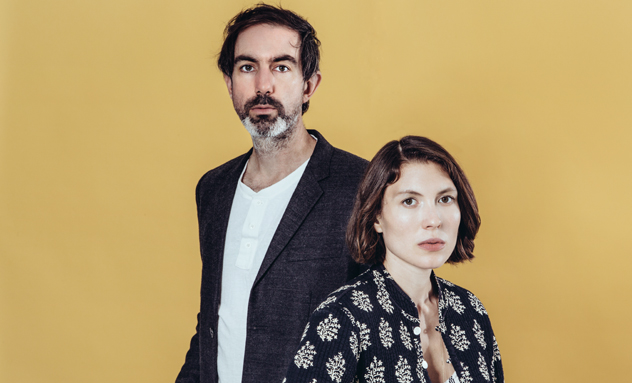
Tell me about how this collaboration came about.
I understand there was a kind of mutual inspirational rut between yourself and Ryan with regard to your next step musically. I have a 2-year-old and last year at this time she was 1. I just didn’t have the time or space to kind of make or create an entire album that was the next Alela Diane solo record. I didn’t have that record in me at the time. Yet, I had something in there, and I was open to trying different sorts of writing where I could just kind of write some words and not have the pressure of it being my next album, my next statement. I ran into Ryan at a show and we just got to talking, and he was talking about being bored making instrumental music. I didn’t think much of the conversation; I just thought it was cool to see Ryan. A couple days later he emailed me and said, “Hey, do you wanna try writing some songs together just to see what that’s like?” I said yeah, and it all happened really quickly and easily, which is exactly what I needed. I didn’t need something that was daunting and difficult. He sent me a bunch of digital files of these beautiful guitar pieces, some things he’d been kicking around. It was a really different process for me to approach his music and think about what I had to say on top of his guitar pieces, because that backdrop was very different than my own guitar playing. I felt like different words were being called to come out of me. It was a really cool way of working.
Once you were in the thick of it with the arranging, writing, etc. what were some of the things that inspired you by Ryan’s playing that you felt helped to bring out the words, the melodies, the whole vibe of the album for you?
His guitar pieces are very intricate, beautiful, kind of meditative; they’re really different than anything I can play on guitar. They didn’t feel like something I could create, so it felt really awkward at first. The very first song I wrote for the project I wrote the way I usually write, which is very much from my perspective from my life, some story about my past and it just didn’t feel right. It didn’t fit well on top of his guitar work. But that was a good awakening; this wasn’t just a platform for me to say the same old stuff. This was something else. With the changing seasons and also getting some insights in certain instances about what Ryan was thinking about when he wrote the guitar pieces, it was an opportunity to observe things from a broader angle: Life on Earth, life as a person on Earth and not necessarily life as Alela Diane specifically. Although, of course because I am me, that does come out. And also, with me having a newborn daughter and thinking about life, like where the hell did this little creature come from with this spirit she has? What does it mean to come to Earth, and what does it mean to leave? Big stuff. This is my version of, “Whoa! This is all crazy! What does it mean?”
When I listen to these guitar compositions, they sound pretty complex to pull melodies out of. Was that difficult for you?
They’re really complex. Some of them I sat with for weeks or a month and just listened and was like, “How the hell? Where is the melody?” The pieces are so rich on their own and the last thing I wanted to do was sing something stupid on top of something that was already beautiful and ruin it. I didn’t want to make the songs worse. So I just listened until I started hearing something. Then I just followed what I heard.
Do you feel like having traveled this new approach to creating an album that it’s allowing you to meditate on how you might present the kind of album you were originally unable to make in the future?
Yeah, I do. I’ve written some songs on my own since we’ve finished this project. I see them all inside myself, even though I haven’t written them yet. I think even just woodshopping things with the computer and recording rough versions, it’s something I’ve never done before on my solo work and I think that that will be a really helpful tool for writing my own songs, and editing and sorting through things and deciding what’s strong and what’s not as strong. Usually I’m pretty old fashioned. All of my records are like I wrote all these songs on only an acoustic guitar. This is what I do and this is all I’m capable of. But I’m trying to think outside of that box.
The process is just as important as the end result.
Totally, I love the process. That’s why I do this. I think writing songs and chasing after a song and having a song arrive out of nowhere is so rewarding. It’s why I keep doing this.
Alela Diane and Ryan Francesconi celebrate the release of Cold Moon Saturday, Oct. 24, 2015, at the Center for the Arts in Grass Valley (314 West Main Street). Show is at 8 p.m. Tickets are $20 for members of the Center for the Arts or $24 for non-members.
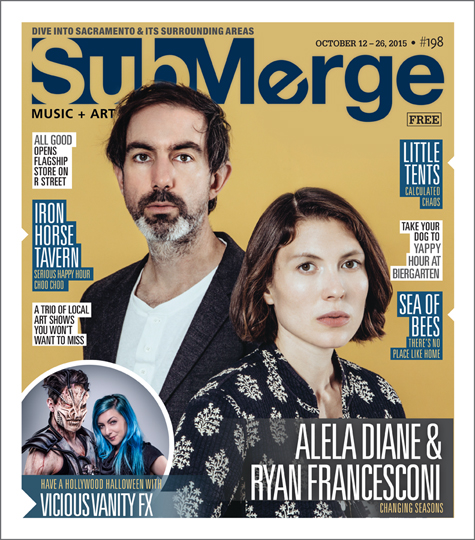
The Song Babies
As a major portion of the greater Sacramento-area music fabric, Two Sheds made a splash with the husband-and-wife duo of Caitlin and Johnny Gutenberger (formerly of Far) crossing streams to generate a truly endearing kind of folky pop. The genesis of that obvious chemistry materialized on the band’s impressive debut LP, Strange Ammunition, released in 2006. Following a subsequent EP release and a period of relative stagnancy, the Gutenbergers packed it up and moved to Los Angeles, Caitlin unsure if her next step was grad school or working further toward her artistic goals with the band.
Lethargy ensued even while new muses were slowly unfurling their bemused little tentacles out toward Caitlin as the viscera of her new surroundings began to take hold. And as it is with all artists, something struck. It wasn’t without assistance, though. Chameleonic Portland musician Nick Jaina, a friend of Caitlin’s, issued a challenge to attempt to write 20 songs in one day. After two attempts at reaching this lofty goal, Caitlin had penned somewhere in the neighborhood of 20 songs for Two Sheds, a feat that far surpassed the piecemeal writing-recording regimen she and Johnny had undertaken in the previous three years.
The result is Assembling, an adventurous collection of stream-of-consciousness arrangements, lyrics and recording techniques. It’s also a dream-like jaunt through hazy poppy fields at the precipice of where slumber and fluid improvisation collide. It’s also just an incredibly good album that hubris would do well to side-step.
Caitlin took some time out to wax with Submerge about the new album, how she’s tired of acting like George Lucas all the time, and the immaculate conceptions of song-babies from the thunderbolts of the ether. It’ll make sense later… Read on!
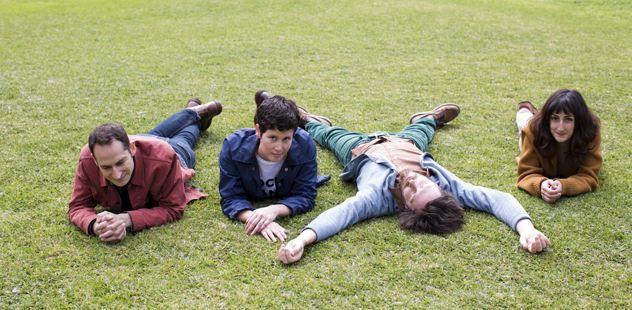
Tell me about how these songs came together. I understand there were dares involved.
Yeah, basically before I wrote the record, I wasn’t really writing much. We’ve always recorded things really piecemeal. It’s been more of a long and drawn-out process, which can produce great results, but I just wasn’t being terribly productive in the songwriting department. So my really good friend from Portland, Nick Jaina, he’d been doing this exercise that he’d been trying to get me to do for a while. It was this songwriting challenge where you try and write 20 songs in a day. Which is ridiculous on its face, but I think the point of it is that you don’t have any time to get precious about what you’re doing or to think about whether or not something is good or bad. It’s just to get through it, which was a really good experience for me. I just did it to see if I could do it. The first time I did it, I wrote 11 or 12 songs, and I was like “Holy shit!” The whole day it was kind of painful and arduous, but at the end of the day I looked back to what I did, and there was some cool stuff in there. So I did it again a month or so later, and I wrote six songs in a day. So I had almost 20 songs, and then around that time we had some friends who own a studio down here [in L.A.] called New Monkey and they had four free days, and said, “Why don’t you come down and see how much stuff you can get done in four days?” We recorded 14 of those almost 20 songs in four days. That was literally the record. I think it’s one of those things that was just good to do. It’s just sometimes good to do things that are seemingly hard or silly to see if you can do it, and I think the cool thing that came out of it was me realizing that if I just go and sit in a room long enough and muscle past the judgment or the gag reflex of initial songwriting ideas, something is going to happen. It was a great experiment for that reason.
As you were going through it, and then the month or so in between those sessions, what strengths or weaknesses did you find you were facing by approaching it that way?
Well the weaknesses are that you don’t really allow yourself the time to fine-tune things. It’s really just about allowing the feelings or the thoughts that you’re having in the moment to come out and sometimes while it’s happening, none of it seems to make any literal sense or you don’t even know what you’re writing about. Then you go back and revisit it when you’re away from that intense day, and you’re like, “Oh my gosh! That song is totally about that one argument I had with my friend!” It’s weird; I had time to think about it in a more analytical way after it was done.
I think the strengths of it for me were just having the realization that if I go in and I work on something and I just allow myself to continue working through something even if I feel like it’s not working out, something can come out of it. Before, I always thought of songwriting as that beam of light that comes down when the clouds part and flashes you in the middle of your forehead and you’re like, “Yes! This is my song-baby that just came to me!” I realized that, actually, having something happen is just something that happens in the middle of you trying to do something. You don’t have to wait for it. It’s great when it is the beam of light, but you can actually also make great stuff if you just kind of look at it more like getting a job done.
I tend to find the more you go back and try to fix something, the less satisfied you are with it. You’re trying to recapture the moment you had when you came up with that idea and it’s not the same. I feel like I tend to George Lucas-ize things more than I tend to Leonard Cohen them, ya know? “Oh what we need in this part of the song is more pod races and more conversations about trade federations!” Then you look back at it later, and you’re like “What the hell was wrong with the demo, man?”
It seemed to me on a song like “You Get to Me” that you weren’t shy about trying different rhythms, and later on the recording, different noises and textures. Can you speak to that experimentation as it relates to the musicians who recorded on the album outside of yourself?
Yeah, well with a song like “You Get to Me,” I wrote this song and it was just this little picky guitar part, which is still on the recording. In general, I’ve always felt like everyone in my band has a really distinct kind of musical perspective. One of my favorite things is writing a song and giving it to my band and seeing how everyone responds to it. We just drew up the demo in the studio, and Johnny was like, “Oh my gosh, it would be funny and awesome to put this Casio beat under it.” We did it and started using it as a click track, but then we definitely started to get attached to it. Our friend was playing piano and we ran it through a Space Echo, because wouldn’t that be fun? It was so stream of consciousness and so not intentional. It was like literally us looking at things in the studio going, “Huh, that’d be fun to use.” It was whoever had the coolest idea at the time while we were just flowing with stuff just tried it. It all just came together. It was really, really fun for that reason.
See Two Sheds live as part of the Davis Music Festival on June 20, 2015, at Odd Fellows (415 2nd Street, Davis). Weekend passes are available for the three-day music fest (now in its fifth year) for just $25. To purchase tickets, go to Davismusicfest.com, where you can also find full line-up information.
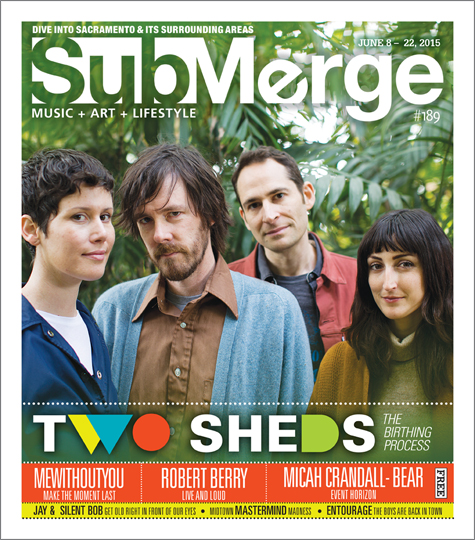
Male Gaze Outruns Ghosts of Projects’ Past on Excellent Debut
Despite the fact that Male Gaze is essentially a brand new band, their collective pedigree has afforded the group the opportunity for larger shows and bigger stages nearly right out of the gate.
“We’ve all been around and we know everybody so it hasn’t been too tough to pull off,” says bassist Mark Kaiser. His matter-of-factness isn’t meant to come off sounding boastful; it just so happens that the folks who make up Male Gaze have logged time in some of Northern California’s more ballyhooed underground garage bands, including Blasted Canyons (guitarist/vocalist Matt Jones), the notoriously anti-Internet Sacramento crew Mayyors (where Kaiser manned bass) and The Mall (drummer Adam Cimino).
The question could remain whether or not that makes the sum of their parts something to write home about. And while it’s tough to get anyone anywhere to write anything down anymore at all, you’ll probably want to at least mention Male Gaze to someone sooner than later. With the release of their seven-song debut album, Gale Maze, on John Dwyer’s Castle Face Records, the band’s relative secrecy is slowly fading.
Before the band recruited second guitarist Adam Finken (also formerly of Blasted Canyons and currently in Tiaras), Gale Maze was recorded in a flurry by the core trio, Frankensteining tones and mixing approaches from their previous projects—if perhaps unwittingly—into a bewitching, fuzzy brew, rich in homage to the likes of Joy Division (Jones’ vocals practically exhume the flat bellowing of Ian Curtis) and a cornucopia of post-punk tinkerers.
The cold truth is that Male Gaze falls into that awkward category of too-soon-to-be-written about, although they did release a 7-inch in July 2014, a precursor to Gale Maze featuring the fantastic tracks “Cliffs of Madness” and “Think Twice” via Kaiser’s Mt. St. Mtn. label. They’ve played a handful of shows between San Francisco (where Cimino and Finken reside), Sacramento (where Kaiser lives) and Los Angeles (where Jones lives). And they have a lot of touring on the horizon, including a set at Boise, Idaho’s Treefort Music Fest this spring.
Even amidst their fledgling nature, the fact that their album resonates so completely forces the hand a bit.
Gale Maze unfolds organically, slowly and somewhat curious of its sonic surroundings on the lead track “Smog Dawn,” unfurling washes of crunchy noise atop otherwise darkly plotted garage-psych. Careful consideration is given to the balance of melody and grime, and to riding hazy waves of echo-delay vocals on tinny wormholes of hallucinogenic rock. It’s a trippy ride, to be certain, and one not altogether uncommon, it must be said, especially for alumnus of the vaunted Castle Face. Where Male Gaze separates itself, however, is in their ability to revel in space-dark choruses and not always disappear into the groove of a 12-minute-long freakout jam cycle. That crevice of psych has its place, it just doesn’t fit within Male Gaze’s current oeuvre.
And while Kaiser’s aware of the band’s past being a talking point for its future, he doesn’t seem concerned with talking much about how it affects how people will perceive his new project. In the interests of articulating the building blocks of Male Gaze, though, he did spend time chatting with Submerge about some of it.
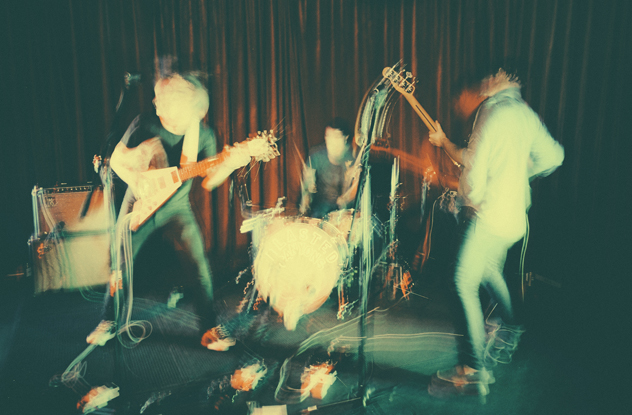
What can you tell me about how the band formed and what each of you were hoping to focus on with this project?
Basically, I was in the process of moving back from L.A. and I was talking with an old friend who was in one of the first Mt. St. Mtn. bands, The Mall [Adam Cimino]. He said he had a practice space and thought it would be awesome if we could jam there; he hadn’t been in a band in a while and was just kind of jumping in on people’s projects or recording with people or playing live here and there. We were just trying to get together and jam to see if we could come up with a concept. Once it started to solidify into feeling like we could totally play together—we had the space and kind of a loose idea of what we wanted to do—we started trying to bring people in. Blasted Canyons had broken up and Matt [Jones] didn’t have anything going on, so I reached out to him. He was someone I knew on the periphery because of Castle Face, who I know as business partners, and I was gonna put out a Blasted Canyons record a ways back, which ended up coming out on Castle Face. He came in and it sort of clicked.
There’s not a lot of material out there about your band, save for the mention of where the three of you came from, band-wise. I do know that the album sounds great though. Do you think it’s probably better that people take your band for what it is now and not for where it came from?
I don’t know. That’s what we’ve been mentioning too, because that just helps people put a face to the name. All those bands were pretty well-known at their time, so obviously we wanted to let people know who liked those bands that we’ve got a new thing going. With the Internet, we can get music out to everybody really quick. We had a single up online for a long time and it circulated a lot. Bios always drive me crazy. Trying to describe music is a painful process. Then it kind of falls into, “well, we sound like these bands” and then everyone names the same bands and we all kind of come from the same punk place of all the music from up here. There are no surprises here. We just wanted to keep things short and sweet. Let the music writers write about us.
Music-wise, do you feel like there are real strong links between some of your past projects?
Yes and no. We weren’t fumbling through those previous projects; they were pretty well thought-out and we were seasoned musicians and we’re older. I feel like those bands all had a bit of…we jelled into each of our own style of playing. We each have our own style of playing, style of writing, so naturally we just kind of shuffle the deck and sometimes there are elements that sound like Blasted Canyons, or sometimes mildly Mayyors-ish. It’s more in sounds and tones as opposed to how we’re writing, and certainly there’s Matt’s voice, which was all over Blasted Canyons. I feel like it’s a pretty radical departure from what we were doing before.
When you first got together and cemented the trio, you had a single up really quickly. That’s in pretty stark contrast to your previous band, Mayyors.
Yeah, I put it out on Mt. St. Mtn. originally, and then we debated. I’d just come from a band who was off of the Internet and really very well-hidden, but that’s not how these guys wanted to play. So we ended up putting the single up on Soundcloud, and I was gonna do that for the label anyway. We had that up and kept recording; it was still really early on. We took what we learned from that and started applying it to recording the whole set and finding out through mixing what we wanted to sound like. It took some time; we recorded and re-recorded a few times figuring out what we wanted to do, and we definitely mixed that record about 10 times. So there was a lot of fine-tuning; we were still pretty new and the set was pretty fresh and we’d only played a few shows. We were just figuring out how we wanted to sound. It’s more of a first attempt than anything, but we’re real happy with how it turned out. It was a good starting point to continuously evolve.
Male Gaze will be joined by Tiaras and Vasas on Sunday, March 29, 2015, at the Hideaway Bar and Grill (2565 Franklin Boulevard, Sacramento). This all-ages show starts at 5 p.m. For more info, visit Last.fm/music/Male+Gaze
Sunmonks and the Organic Evolution of Sound
The day after Halloween carries with it the reputation for temple-crushing recollections of a costumed evening prior spent howling at the moon. Burning the midnight oil. Chasing the dragon. Whatever your bag may be. When I catch up with Sacramento’s Sunmonks, it’s as if this were some distant reality unlikely to affect them, rather than the possibly rough-hewn phoner I’d partway anticipated. After all, we’re talking about a band here. It’s not as if musicians don’t hold their own reputations for debauchery even without the benefit of an annual excuse.
The fact that Geoffrey CK (vocalist, guitarist) and Alexandra Steele (vocals) were unaffected, uninvolved and ostensibly clear-eyed as we spoke Nov. 1, 2014, over what may have been a PA system/speakerphone hybrid at an unidentified house speaks more astutely to the nature of their music than you might think. Centered as they are around mitigating the dependencies of contemporary approaches of songwriting, Sunmonks’ tendency to side-step the familiar has become a strong-rooted foundation on the relatively new group.
“We’ve written a lot of songs that we haven’t recorded and that will never be recorded and that we wouldn’t be able to remember,” explains CK. “We’ve written a lot of songs we won’t perform, that are kind of dead. So in one sense, we’ve been a band for a long time, or at least a duo for a long time. But we just did it because it was part of life. Now we’re making our whole life music instead of having music be part of life.”
CK and Steele met in 2005, as they report, both immersed in a tight musical community in and around bucolic Auburn, California.
“We didn’t really care that the other of us played music,” says CK. “We just became friends and hung out a lot. I would write songs and play in bands and she would be around. Sometimes a band I would be in session with or playing live with would have a part they’d want sung and because she was there she would sing it. People liked it, so we started to play together.”
It wasn’t until around 2012 that CK and Steele settled on the direction they wanted to move toward as a musical entity, together. Prior to that, the duo wrote songs and sang together without any intentional path. Utilizing the admittedly modern benefits and staggered, textural whimsy of a loop station, CK began crafting songs like building blocks, creating demos by stacking parts over acoustic guitar and adventurous melodies and harmonies between himself and Steele. The formative wellspring of what would become the Sunmonks sound and ethos—so innately anti-modern—was stemmed from incorporating very modern technology.
This fact is important to the story of Sunmonks. Their debut EP In a Desert of Plenty—released Oct. 28, 2014, via Crossbill Records—explores themes, rhythms and melodies culled from myriad primal influences. Eschewing the parameters of what CK describes as a “paint-by-numbers” approach to songwriting, Sunmonks’ compositions are put through rigorous litmus tests by the band—now also including Julian Loy and Dave Middleton on drums and bass, respectively—unspoken though they may be.
“There’s no wrong way to make music,” begins CK. “But in terms of how much fun you’re having or how much you want to surprise yourself, I think it’s a lot more fun for us to play with people and even to start writing with people than recording yourself as a person on a computer.”
“Geoff still makes demos [with a loop station],” clarifies Middleton, “but he’s a great writer and arranger, so they come fully formed. A lot of music is written with loops in modern times, but one of the unique advantages from taking a looped composition and laying it out organically is you get these unique moments of chaos or these little human things that wouldn’t otherwise happen. I feel like that’s where we’re at now.”
For CK, citing inspirations like David Byrne and Fela Kuti (some symbiosis of the two may approximate the percussive-heavy, tribal pop R&B mish-mash of Sunmonks’ oeuvre) instigates the internal conversation he has regarding what the purpose or relevancy or resonance a particular song might have prior to even being shared with anyone else.
“It’s a more religious experience instead of a more scientific experience,” says CK. “That’s something that really excites me about music in general: some deeply profound or magical, primitive thing.
“People who write using plug-ins or gridded beats or things like that, I don’t know that they necessarily intend on having a religious experience while they write. Oftentimes it’s sort of feeling their way through it. It’s like, ‘this is super dark, so I like it,’ or ‘this is intense, so I like it.’ Then a listener hears that and they have a religious experience. Which I guess is the point anyway. But with me it has to start that way or else the song doesn’t survive the point where I can even show it to anybody else.”
On Desert of Plenty, the EP’s four songs play from most recent song written, to oldest song written, alluding to the recording’s nomadic snapshots, as this collection of songs was written and recorded over long periods of time and in mostly different locations. In an attempt to include some sonic congruency, the four songs were mixed together at Panoramic House studios in Stinson Beach by the band’s producer—and Tape Op publisher—John Baccigaluppi.
Special attention was given to eliminating the use of cymbals, as Afro-beat progressions bubble and bloom throughout the title track. Elsewhere, on the outstanding tune “The Deaf,” Sunmonks’ affinity for superb horn arrangements, densely layered textures and feel-good romps ripe for dance-alongs is made plain. Geoffrey and Alexandra’s voices weave together in primeval harmonies, expounding ancient melodies that create bridges between the organic inspirations they covet and the contemporary crutches they’re all but beholden to. To wit, the band says Desert of Plenty is a record of where they’ve been, with their upcoming 2015 LP aiming at where they are now.
The fantastic “Golden Words” ushers in yet another dynamic for Geoffrey and Alexandra’s quiver of songcraft, with fissures of funk cascading over sultry R&B melodies. Still, overused genre classifications do little to discern the lively vibe of Sunmonks’ sound. Those aural observations, as we’ve learned, are triggered by the energies dispersed during the composing of the songs.
“The Sunmonks stuff has to be instantly recognizable as Sunmonks stuff,” explains CK. “It just is Sunmonks stuff or it isn’t Sunmonks stuff. We tend to know that from the beginning of the song, when it starts to appear. When we get to the barking stages, and we’re barking at each other.
“Something stuck with me a while ago where someone was talking about arranging, and they were talking about there being certain rules for using brass, or certain rules for using guitar and a rule for Sunmonks is using [the instrument] not how it’s supposed to be used. Or at least trying to. The anecdote was described as everything being a drum. To not necessarily treat a guitar as Jimi Hendrix would have treated it or as Django Reinhardt would have treated it, but to treat it like Ginger Baker maybe would have treated it.”
Sunmonks vinyl release show for their debut EP, In a Desert of Plenty, is on Sunday, Dec. 14, 2014, at LowBrau (1050 20th Street). They will also perform at Old Ironsides (1901 10th Street) as part of Lipstick’s annual New Years Eve party on Wednesday, Dec. 31, 2014. For more info, visit Sunmonks.com
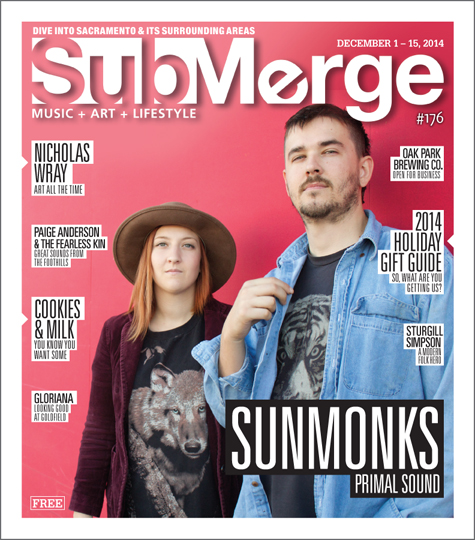
Weezer’s Ninth Studio Album Promises Return to “That” Sound…and Delivers
These days, mention the name Weezer and you’re bound to hear essentially two types of responses. 1) That they stopped listening to the band after their then-comeback self-titled third album, colloquially known as The Green Album, thereby avoiding the debatably unlistenable albums that followed; or 2) That Weezer is the greatest rock band on Earth, regardless or perhaps because their openness toward experimentation. There is very little even ground.
The rub is that after Rivers Cuomo, Pat Wilson, Brian Bell and Matt Sharp formed in 1992 in Los Angeles, there likely was no real plan other than to set Cuomo’s pitch-perfect slacker vocals to heavy rock guitars, like a sort of Beach Boys on steroids or a surf-bleached Kiss. Throughout their career, each of Weezer’s albums has come from inherently disparate headspace (metal, alt-rock, even hip-hop), despite being relatively conservative with its sonic loyalties. But backlashes happen, and for a world that wanted Weezer to reign as their nerd-rock kings forever, disappointment was inevitable. No one could have anticipated the band’s penchant for experimentalism after The Blue Album and Pinkerton set the table for modern emo.
The band’s upcoming album, Everything Will Be Alright in the End, is being touted as a return to “that” sound for Weezer. That band who stormed out of the gates on the backs of “The Sweater Song,” “Say It Ain’t So” and “Buddy Holly.” That sound that set them apart from most every band performing in the mid-‘90s.
And the thing is, they nailed it.
Of course, this is a matured, weathered Weezer now, so the exact magic of their former incarnation has merely transmogrified. But the songs are there.
Manned by Ric Ocasek—who famously engineered and produced the band’s most well-received, early albums in The Green Album and The Blue Album—Weezer went “back to the shack,” as Everything…’s single relates, to recreate some of the wizardry of their formative years.
Back in fighting shape after a hiatus of four years, longtime Weezer bassist Scott Shriner is understandably excited about the new album. In advance of the band’s appearance at Aftershock in Sacramento, Shriner took some time to wax with Submerge about Everything Will Be Alright in the End, set for release Sept. 30, 2014.
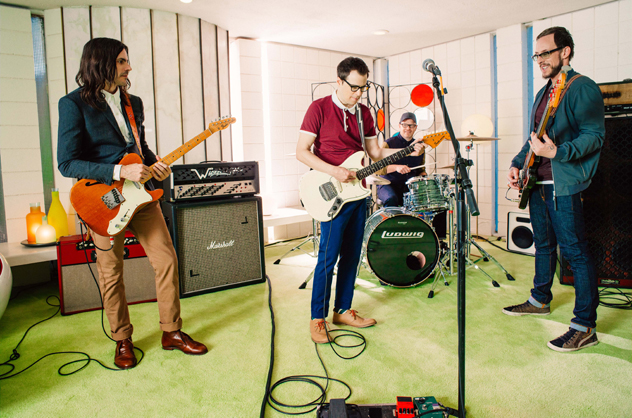
{Photo by Brantley Gutierrez}
Everything Will Be Alright in the End is being touted as a return to “that” sound for Weezer. What to you is “that” sound, and how was it to return to some of those elements that the band became defined by?
As you know, we’re working with Ric Ocasek, who’s an absolute legend, a beautiful man and human being. There’s a certain kind of magic when we work with him, and it influences the way we play and the way we interact with each other. We’re just really focused on being the best band we can be right now.
So does that chemistry between the band and Ric bring out new areas of creativity, or does it allow you to take greater risks? Or is it more Weezer trying not to take as great of risks musically here?
To me, we’re taking the biggest risk we’ve ever taken. Ric somehow just keeps it—I don’t know if I’d say he keeps it honest or that he keeps it “Weezer” or what it is—but the band itself are the keepers of the Weezer flame and are trying to make it bigger and brighter. Ric is an amazing cheerleader, and he’s not afraid to say, “You guys are fucking up right now,” or “That’s a terrible idea.” It’s not like we do everything he says, but when he says something like that, we really hear him. I think his ability to say something like that makes me also really believe him when he says, “This stuff sounds great,” “That was a great idea” or “That was a great take.” It’s not someone just in there yelling, “Go team!” even when you drop the ball. He’ll just have us all do it again until we get it right.
How collaborative was the songwriting on the new album? I know you, Pat and Brian have been given more opportunities to shine on recent albums, but this one sounds like it’s pretty much all Rivers…
On this album, we really wanted Rivers to steer the ship as far as the writing went, and the same thing with lead vocals. I got to sing lead vocals on a song or two in the past, and it was really great for me, and a great chance to grow, musically. Rivers…he’s one of my favorite singers on the planet, so personally, I’d rather hear him sing over myself any day of the week.
Well you’ve been in the band now for 13 years, by far the longest tenured bassist. What have you observed the most about changes in the way the band goes about the business of making music?
One thing I know about Weezer is we do not do things the same way record to record. We come at all these different records completely differently. I’ve found that it’s best to be flexible and not get too attached to one particular way of doing it because we’re probably going to do it differently the next time. I like being in a band like that because I get bored really easily and I need to be challenged constantly. It’s always a growing and evolutionary kind
Big Business on Post-Label Life and Battlefields Forever
When I catch up with Big Business guitarist Scott Martin, he’s exiting a restaurant somewhere between Dallas and Nashville, a little frazzled from an evening prior when he and his Los Angeles-based band mates played a gig at the Gas Monkey Bar N Grill, opening for The Sword on their U.S. tour. These are the first live dates that Big Business has had the chance to play since the Halloween 2013 release of their fourth album, Battlefields Forever. Bassist/vocalist Jared Warren was expecting his first child around the release date, which meant that the road would have to wait.
Their Dallas stop was a memorable one, as Martin reports.
“A guy at the show last night flew in from Sweden,” says Martin. “He heard us on a Sword channel on Spotify, and it played us and he was like, ‘What is this?’ and he flew to Dallas.”
The hubris of this kind of interaction might come off as garish, but Martin’s reference of it is, in fact, at the core of Big Business’ modus operandi as a band now: The little connections made as part of life as a small business.
“I’ve had label experiences where I’ve done all the artwork for the record, yet the label charges us thousands of dollars for art,” says Martin. “You get an itemized list of things they charge you for, and it’ll be like $5,000 for radio, and, you know, no one listens to radio. [With our own label] we know exactly what we’re spending on what, and with us, the most important things are the songs and doing justice to the music we’re writing anyway. All the other stuff has just been a natural series of events.”
Battlefields Forever is actually the third release on the band’s Gold Metal Records, following two Big Business EPs, including 2011’s seismic Quadruple Single. The self-run label—currently housed at the band’s rehearsal space—serves as a vehicle for the fuzz-metal trio to produce and distribute their music on their own terms. Everything from the artwork and layout of the album itself, down to overseeing the actual pressing of the vinyl, was meticulously lorded over by the band. Martin, Warren and drummer Coady Willis bypassed the typical pre-release buzz-game that nearly every band succumbs to in order to get heard. That meant no album advances, no PR campaign and—perhaps most riskily—no distribution deal. That decision, coupled with a temporary moratorium on touring, meant that for the larger populace of music-listeners, critics and magazines, Battlefields Forever was unveiled with all the fury of a mewing kitten.
That is, until you listened to it.
Charging from the get-go with a driving, battle-ready drumbeat, the symbiosis of Warren’s ferociously crunchy low-end is rounded out by Martin’s sludgy accompaniment. Whereas 2009’s Mind the Drift—the band’s last LP for now-defunct metal label Hydra Head—still centered the band around the technical proficiency and rhythmic counterpoints of Warren and Willis (Martin came on board in 2010), Battlefields Forever steadies the ship a bit, allowing a depth of instrumentation to navigate songs through wily walls of fuzz on tunes like “No Vowels,” “Trees” and “Doomsday, Today!”
“All the sounds on the album are our amps,” says Martin regarding any conscious aural or evolutionary decisions made for the album. “That’s what we sound like.”
Calling on their friend Dave Curran—who mans bass guitar for Unsane—to produce the record, Big Business holed up at Entourage Studios in North Hollywood for an intense two-week session that was later mixed at Seaside Lounge in Brooklyn, N.Y., by Curran and producer Andrew Schneider.
“We were paying the studio out of our band fund money, and the clock is ticking when you’re in that situation. So we banged it out pretty fast,” reports Martin. “We were really prepared, so when we went in and tracked everything, I’d already known what overdubs I was gonna do because I use ProTools at home. I’d go home after practice and figure out what other parts the songs needed. We were all technologically savvy in that way. Since it was our responsibility, we basically barged in the door, worked our asses off and left.”
That the album may just be the band’s crowning achievement musically is all the more impetus for them to have taken the reins and done things the right way for them. The incubation period before they could tour the album, too, was likely a blessing in disguise. After all, their current tour is their distribution deal. And it’s a good one.
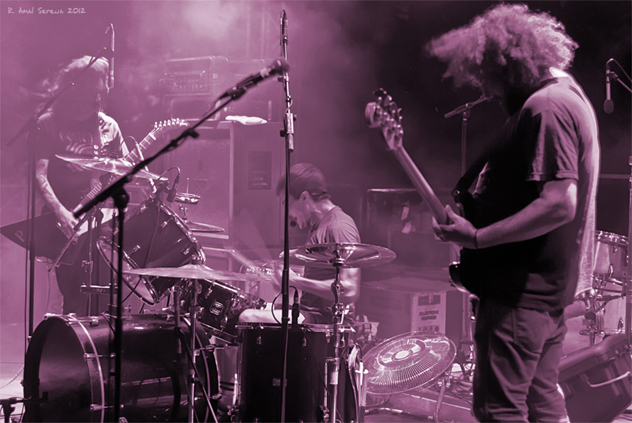
(Photo by R Amal Serena)
“Since we don’t have a distro deal, this is kind of it,” says Martin. “We’re traveling around selling our record. Because we run everything, we also talk to the people who buy our stuff and listen to it. We have a close relationship with them. They make suggestions and we try and meet somewhere with them.”
Even when considering merch sales, the band has successfully eliminated a swath of cash-grabbing middle-men by utilizing the services of online marketplace IndieMerch, who more formally facilitate T-shirts, posters and other bits of swag for artists. The company also provides services for the operation of online retail channels for bands and labels. IndieMerch’s back-end software supplies the band with real-time sales reports, and it pays on demand. That means that any time anyone buys a Big Business LP through the online store, the band can view the sale and collect the money right away.
Martin hopes to see a future where more bands adopt the practice of foregoing the perhaps-tempting route of the label/PR machine and just put some elbow grease into a truly DIY system.
“It’s not that difficult to do on your own,” explains Martin. “We have a name for ourselves after being around for so long, but it’s all really easy stuff to do. Hopefully the protocol of how albums are released, just generated out of hype and whatnot, I hope there’s a big change in that. I hope people start doing things for themselves, like this. You just source out the jobs amongst each other and figure out how to make a record.
“Everybody that has gotten hold of us or done anything with us regarding the record has all been through their terms and it’s a mutual working-together situation. It’s really awesome.”
Big Business plays at Harlow’s (2708 J Street) Wednesday, March 19, 2014, along with O’Brother, opening for The Sword. The show is 21 and over and starts at 8 p.m. Tickets are $20 to $25. For more information on Big Business, visit Bigbigbusiness.com.
Oleander Returns with a Defiant New Album, and a New Lease on Life as a Band
Don’t worry; you’re forgiven if you don’t immediately recall, recognize or even remember Sacramento modern rockers Oleander. Unfortunately, that’s just the way the music machine operates. The band, which got its start in Sacramento nearly 20 years ago, hasn’t released an album since 2003’s Joyride. Even more time has passed since the band had a successful single: 1999’s February Son featured the hit “Why I’m Here,” a modern rock radio staple that’s still played to this day. But in an age when content saturation—mostly online—is paramount for a band’s survival in the public eye, it’s possible that 15 percent or more of you have no inkling of what or who an Oleander is.
To edify, Oleander were born out of the uprising of the post-grunge set that flooded rock radio and MTV following the unexpected successes of Nirvana, Pearl Jam, Soundgarden, et al. Contemporaries amongst this tributary of guitar-heavy, brooding rock crews are either still moderately well-known (Bush, Matchbox Twenty) or have been summarily abandoned, fairly or not (Seven Mary Three, Candlebox, Silverchair). Within this ridiculous kind of parameter, it’s equally ridiculous to try and position Oleander into either of these camps. To their credit, the band—vocalist Tom Flowers, bassist Doug Eldridge, guitarists Ric Ivanisevich and Rich Mouser and drummer Steve Brown—have rarely wavered from the musical motif they generated when they first began, lending them integrity and a resiliency that is rare in a lot of groups who were chewed up and sort of spit out by the business.
After a lengthy hiatus following the Joyride tour—the band insists they never broke up—Oleander have revitalized their outlook on being a band, and have taken their time to reinvigorate the rush of creativity that their first few releases inspired. Their new album, Something Beautiful, exudes that resiliency through powerful chord-mashing, heavy drums and anthemic rock ‘n’ roll. They’re ready to take the next step forward together, as Flowers discussed with Submerge from his home in Los Angeles.
Oleander has been described as underdogs. Is that a pretty accurate description of how you and the band feel?
I think the odds are stacked against any band at any given time to be able to be successful in the music industry. Very few bands get signed; fewer than that sell records. When we were coming up, we definitely had to fight our way to opportunities, and then we had to fight our way through challenges. We were fortunate enough to have achieved a certain level of success, at least once we got the first record out there. Certainly “Why I’m Here” went a long way for us. We’ve always played with a bit of a chip on our shoulder; that’s just who we are. After taking such an extended break from activity and the business, we feel like once again we’re going to need to defy some odds to reestablish ourselves. I think it’s a lot easier to come at it from a humble perspective rather than assume that you’re something that in reality you’re not. When you come at it from that perspective, you end up taking things for granted and that’s not a position we want to find ourselves in.
Things have moved at a deliberate pace for Oleander since you guys reformed a few years ago.
Yeah, we got back in the same room and back to enjoying each other’s company in a rehearsal setting, knocking the rust off of the guitars and the amps and reacquainting ourselves with some of the songs that we’ve played millions of times over the years. We slowly grew more and more comfortable with being in the room together and 15 minutes into the first rehearsal, we’d basically written “Daylight,” which is one of my favorite songs on the new album. We’re looking at each other and the hair on my arm is standing up and we realized that there’s something very special going on right now.
One of the positive byproducts of that break was that we were able to discard a tremendous amount of clutter and baggage that we’d accumulated after so many years of grinding it out on that treadmill of the industry. Constantly writing, recording, packaging, promoting, touring, again, again, again. The break really gave us an opportunity to breathe and gather our senses a little bit and get back to what we experienced with that first rehearsal where we were having fun. It wasn’t much fun toward the end before we walked away.
So it was more a series of events, not one in particular, which led to the hiatus for the band?
There was no identifiable moment. The year we started to step away for a minute was I think we’d come off about 200 days in that year that we’d been out on the road. We’d talked about taking a break for a while, a short break, just enough for us to go back home. You’ve got to imagine, when you’re living on the road constantly, we left behind our families and our friends, and we were missing out on birthdays and funerals and weddings and life all for the sake of promoting the album du jour. It’s an honor and a privilege to be able to do that for a living—don’t get me wrong, we’re incredibly grateful to have had that experience and to have it moving in the foreground again—but it comes at a cost. Before we took the break…everything we got into this for, everything we were enjoying at the beginning wasn’t there anymore. That’s not how it should be.
Did you always know you’d likely return to the project?
We didn’t know exactly when we were going to get back into the room and recommit to doing it again. I’ll be honest with you, we got home and it was really nice. The things that people take for granted or that they consider labor we considered fun. Doing dishes, mowing lawns, raising kids and having stability on a regular basis, that was kind of unfamiliar to us because we’d spent so much of our lives just getting into a vehicle, getting from point A to point B, waking up, getting ready for a show, doing press, shaking hands, meeting people, signing things, getting in the bus, taking off, going again. It took me about a month-and-a-half to get comfortable sleeping in an actual bed. I would always end up on the couch because the dimensions of the couch were similar to the bunk I’d been living in on the bus.
So then even when you got back into a room together to play you didn’t feel pressure to produce something right off the bat…
No. I don’t know if you’ve heard the record, and I don’t know what you think of it, but from my perspective it’s our best album to date. And I know every artist with every new album, they think it’s their best piece of work. But I honestly believe it. It’s a direct result of the fact that we had all the time in the world to spend every minute getting attention to every detail possible per song. We had zero pressure. We didn’t have a label over our shoulders telling us to hurry. It was just doing what we wanted to do, getting back to what we got into this in the first place for, which was just being creative. It’s very similar to what we did with February Son; we had our whole lives to write that. From that point forward, though, it was just a constant grind.
It sounds like a very resilient, uplifting album.
Yeah, it is. Something about this band and something about our experience as a band that harkens back to the underdog theme is that we definitely know what it’s like to get the shit beat out of us and to face a few options. You’re either gonna take the left turn or the right turn; you’re going to get up or you’re going to stay down. We’ve always rallied around our mistakes personally and challenges we’ve faced as a band and gotten back up. I really wanted to portray that kind of spirit and attitude in these songs, and I kind of always have. There’s a recurring theme to every album. That’s how my life’s been, a lot of ups and a lot of downs…mostly ups. We’ve figured out a way to turn lemons into lemonade.
Oleander is releasing their new album Something Beautiful Friday, May 3, 2013 at Ace Of Spades (1417 R Street). Allinaday, Track Fighter and G.O.D. open the show. Doors at 6:30 p.m. Tickets are $15. Go to Aceofspadessac.com for tickets. For more information on Oleander, visit oleander.net, Facebook.com/oleanderband, or follow the band on Twitter at @OLEANDERBAND.

Hot Water Music’s Return to Recording and the Road
That Gainesville, Fla.’s Hot Water Music has become the elder statesman of the post-punk renaissance, first sprouted during the mid-‘90s, isn’t much of a surprise. The quartet—helmed by vocalists/guitarists Chris Wollard and Chuck Ragan, and rounded out by bassist Jason Black and drummer George Rebelo—exploded onto the scene a gang of growling ruffians with their 1995 debut, Finding the Rhythms, and two years later with the seminal LP Fuel for the Hate Game. Those touchstones simmered with the roaring vocal delivery of a New York hardcore crew, bolstered by the indomitable rhythm tandem of Rebelo and Black. Volleying guttural, emotive refrains bent on unity and a smattering of angst, the band acquired a fiercely loyal fan base helpless to ignore the dynamic of melodic rage the band had perfected.
Then came the ‘00s, a decade that saw the band struggling to maintain the camaraderie that had catapulted it onto big-time tours and found it flirting with mainstream notoriety. After Ragan left the band in 2005, HWM went on hiatus, then outright disbanded, allowing for a flurry of side projects that became full-time gigs—namely The Draft, featuring Wollard, Rebelo and Black; and Ragan’s fantastic folk-roots solo project.
With the spring 2012 release of Hot Water Music’s first album in eight years, Exister, the band has found itself in the familiar position of endless months of touring, a positively ravenous fan uprising and a return to the energy that spawned seven LPs and countless EPs prior to its break. Black says the hiatus, and the collaboration with new projects and different musicians, was a necessary hurdle for the band’s evolution.
“It’s great to be able to play with other musicians,” says Black. “If you’re constantly playing with the same people doing the same things, it’s fairly hard to grow. We’ve always been interested in evolving as a band and as musicians, so doing other projects [was] a big help for us. We’re all vastly different players and songwriters than we were when we did The New What Next, and that’s completely attributed to these outside experiences.”
The last album the band released before Exister, 2004’s The New What Next, seemed poised to set up HWM for a big splash commercially. The album was the band’s third for indie monolith Epitaph Records at the exact fulcrum when the label was diversifying its catalog and generating more attention during the mainstream’s sudden Panacea shift toward looking at indies—again—for the new what’s next.
To be accurate, the band had no hardship breakdown that caused its temporary pause, no mid-tour fisticuffs or hush-hush drug addiction salaciousness. In fact, within two years of its split, HWM reconvened to perform live in their hometown. That one-off show snowballed into a few more, and a few more here and there until that bigger itch was finally scratched with the making of Exister.
To reign the whole thing in, HWM called upon legendary punk drummer Bill Stevenson (Descendents, Black Flag), and his Fort Collins, Colo., compound The Blasting Room to do the honors.
“Working with Bill and Jason [Livermore] at The Blasting Room was amazing,” relates Black. “They just fully understand our band and know how to make us a better version of Hot Water Music without influencing the material at all. [They produced] with vibe more than arrangements.
“We’d been working on the songs for Exister on the road for a while. I believe it was either ‘The Traps’ or ‘Mainline’ that came together as a band first. It was a great feeling; playing new material always is.”
The band had to adjust its writing routine, too, what with the members now residing all over the country. The band found the comforts of the digital age an invaluable asset in getting back into the swing of HWM 2.0.
“It’s been eight years since we’d released new material, so this was really the first record we’ve been so intertwined with the digital technology side of things,” says Black. “Being able to send song ideas back and forth was extremely integral to getting this record done.
“There was definitely an urgency to the writing and recording process that wouldn’t have been present had we all lived in the same area. Knowing you have X amount of time to write and record helps keep you from ending up writing and re-writing yourself into oblivion.”
Exister sounds as raw as some of HWM’s earliest material, replete with Ragan’s shredded-larynx lullabies, given a vehicle via anthemic, melodic punk rock riffage and driving rhythms. Songs such as the aforementioned “Mainline” exhibit a more stripped-down, straight-ahead approach than technically Herculean LPs like Fuel for the Hate Game. Black’s assessments of the band’s divergent methods for songwriting compared to before the band’s break is evident in Exister’s timeless takes on rock ‘n’ roll archetypes: huge choruses, deft songwriting by both Ragan and Wollard, and an almost irrevocable patina of singularity.
Simply put, Hot Water Music just doesn’t sound like anybody else, even when they’re playing Russian roulette with the recipe.
So what’s the secret to their success?
“It’s a pretty cliché answer,” says Black, “but we definitely wouldn’t be around at this point if it weren’t for our fans.”
Hot Water Music performs at Ace of Spades (1417 R St.) Thursday, Feb. 7 with openers La Dispute, and The Menzingers. Doors at 6:30 p.m., tickets are $18. All ages. For more information, visit Aceofspadessac.com.
For a wide swath of the country’s electronic music lovers, Portland’s Starfucker is a bit of an anomaly. Consider first the group’s somewhat reluctant allegiance to its own name. The edginess of the Starfucker moniker had in fact started as a sort of rough experiment by primary songwriter Josh Hodges to see how far, if at all, such an abrasive handle could go. Before they could find out, the band made a publicized switch to the name Pyramid, which was soon after morphed to Pyramiddd.
Undeterred in the crossover was the project’s loyalty to deep house beats, swelling synths and clunky pop guitar lines, helmed by Hodges’ battery mates Keil Corcoran (percussion, drum machine), Patrick Morris (guitar) and Shawn Glassford (bass). For all those club-ready beats, however, appeared Hodges’ decidedly macabre fascinations with death, dreams and all things dark, providing a brooding insight to a gifted and perhaps troubled sort of modern songwriter.
The band returned to its original name of Starfucker in 2010–though they augment it arbitrarily to STRFKR depending on the phases of Jupiter’s moons (kidding)–no worse for the wear, and have finally put all that goddamn name rigmarole behind them.
Reptilians, released in 2011 on the Chicago indie label Polyvinyl, is Starfucker’s most ambitious album to date. Reptilians continued Hodges’ sweeping new wave melodramas with auditory bits of pop-rock panache, typically morbid lyrical swipes and snippets of lectures by famed British philosopher Alan Watts. The album was the first for the project that included a more collaborative approach between all of the band members, though to pinpoint at which intervals would have been difficult given Hodges’ somewhat ironclad creative grip.
A year-and-a-half removed from Reptilians, Starfucker is hitting the road again for a fall tour at the tail-end of engineering their second release for Polyvinyl–an as-yet-untitled, 15-track LP that Hodges explains is similarly dark, similarly upbeat and plain old similar to his band’s prior output. It’s a good thing, then, that said previous output is so unfairly catchy. To boot, Hodges tells Submerge that Starfucker’s new album–to be released in February 2013–is the band’s most collaborative effort to date.
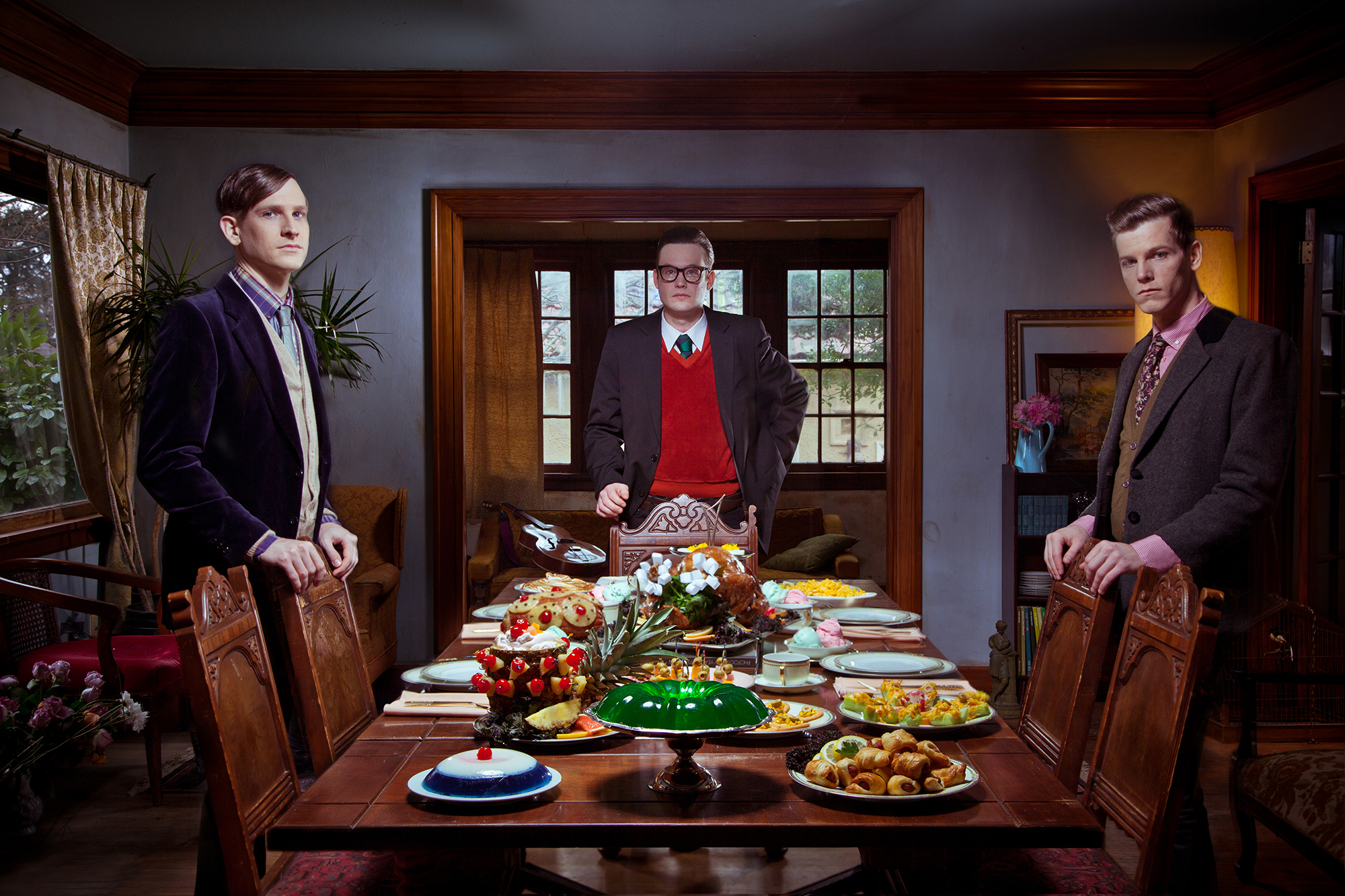
Reptilians dealt with a lot of darker kind of imagery, but retained an upbeat, dance-y ambiance throughout. As a songwriter creating through a pop prism, how do you reconcile that dichotomy?
I think they go together well. Every one of our albums has been like that, but this new one is probably even darker. I just like to write about what I think about, which is death and change. The way our society is, and the way we all think about living is silly considering how people often say, “Oh I would have changed things if I’d known I was gonna die, and not cared about so much bullshit.” We all know [we’re going to die]. In one way or another that’s what the lyrics are always about. I mean, it’s still fun to dance. When I started Starfucker, I was bored of going to shows. The way that it’s interesting is if you can dance–even if you’re into the music–you can still have a good time. Or if you don’t dance, and end up at a dance-y show with your friends, the music is still songs you can listen to that are saying something and not just techno music. The songs are definitely focused on making music that’s fun to play live. I think they go together well, to talk about potentially dark things and then have music be lighter or hopeful. I’ve always liked that and like when other artists do that.
Did you grow up listening to electronic pop bands that had that more cerebral, thematic motif?
I didn’t really. I didn’t like electronic music when I was growing up. I just got some keyboards and thought, “Oh this is actually really cool.” I think I always liked darker music. I think with Starfucker, a big part of it is listening to it at home and reading the lyrics, but then a lot of it is emphasis on the live show, and on living right now and getting a break from the boring stresses in life. It’s nice to go to a show and forget things for a minute, especially if dancing is your thing.
Have you had conversations with fans of the band, where they were into that same contrast? Like maybe they weren’t exactly privy to the darker lyrics, but more reeled in by the dance-y music?
Yeah, definitely. That’s one of my favorite things about having this project is talking with people who come out. I always hang out after shows and talk to people at the merch table or write to them on Facebook. I’ve met some really cool people and have had some really cool conversations with people about that. Also, just the little bits of Alan Watts on the album that’s started some really good conversations with people. I’ve had fans come up and say they’d never heard of him, and then they started getting into him. It’s cool to expose someone to something new like that. And it’s cool to have cool conversations with people about it [laughs].
I would imagine on tour, any time the conversation errs outside of “how’s the tour going?” must be refreshing.
Yeah, totally. It’s super refreshing.
What new fascinations or themes have you been focused on since Reptilians’ release that you may explore on your next album?
It’s a lot of the same stuff, just a different take on it. It’s a bit darker, but still really playful. There’s a lot of dream references in it, too. I had dreams where I was dying and laying on my death bed that seemed real. Patrick has really crazy dreams, too. I guess death and dreaming…
Is it a scenario where those themes are driving the direction of the music in any way?
Yeah, maybe. It’s still upbeat; it’s still happy. But there’s just a little darker stuff on this one than the other albums. It’s longer than the other albums, too. There’s more diversity. More than half of the album has more organic instruments on it, and not as much synth.
I wondered if you’d explore that more. On Reptilians, songs like “Born,” “Astoria” and the title track had a starker, avant-rock kind of sound. Is that a direction you can see Starfucker going toward more as a project in the future?
Yeah, I mean the first half of the new album I wrote a lot of the songs on guitar, so it has that kind of vibe. We’re adding stuff to it now. And I wanted to make part of the album have this super happy feel–we were calling it The Drunk Album for a while. It has a lot of really weird bendy guitars and stuff.
So there’s no reticence on your part to stray too far musically from the project’s primary roots in dance and pop?
Well, I still wanna keep it with the same basic idea, which is a happy, positive vibe. I wouldn’t wanna go too far away. I am a little bit hesitant. I think all of the songs on here are either dark and dance-y, or fun, but maybe not as dance-y. They all still have that playful vibe that I think is important.
For the last album, you allowed additional help from the rest of the band members to round things out musically on record. Are you taking that approach on this new record?
Yeah. This is definitely the most collaborative album we’ve ever done, and it’s been really fun. There are even two songs on the album–one Keil started and one that Patrick started. It’s really awesome. It’s still mostly songs that I wrote and then we fleshed out together, but even Shawn helped me finish words. It’s actually what I always wanted this to be: more of a band, and not just my project.
Are you finding that liberating, to allow this thing that was once mostly yours to become collaborative?
Yeah, it’s like being a parent. It’s nice to have more than one parent to raise the kids [laughs]. It’s nice that we’re all working together; I like that communal feel. We feel like family.
Can that more organic approach for the new album you were talking about before be attributed to that collaboration?
No, I have to fight for that. Keil hates anything not electronic. But I’m still going to do what I want if I have a song I really like. But we pretty much agree on everything at this point. The less electronic stuff, Keil just doesn’t get. He knows it though, and is like, “Well if you guys all like it…” It’s still pretty democratic. If someone really likes a song and fights for it, I’ll give in.
Get your gloomy dance on at Harlow’s Oct. 17, 2012 when Starfucker makes a stop in Sacramento. The show starts at 8 p.m. and tickets are just $15. Go to http://harlows.com/ for more info or to purchase tickets.

